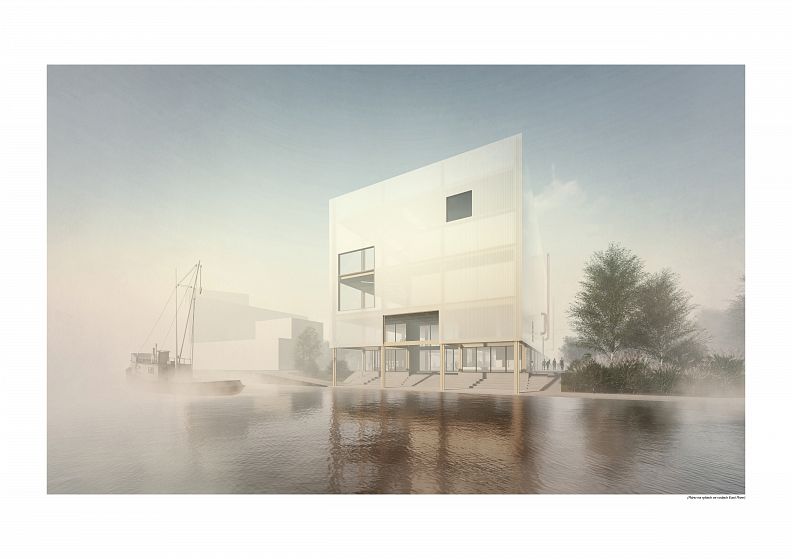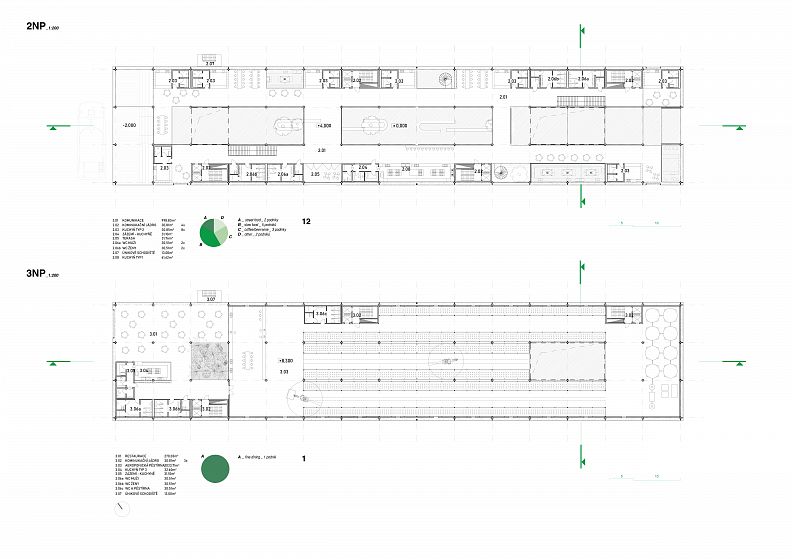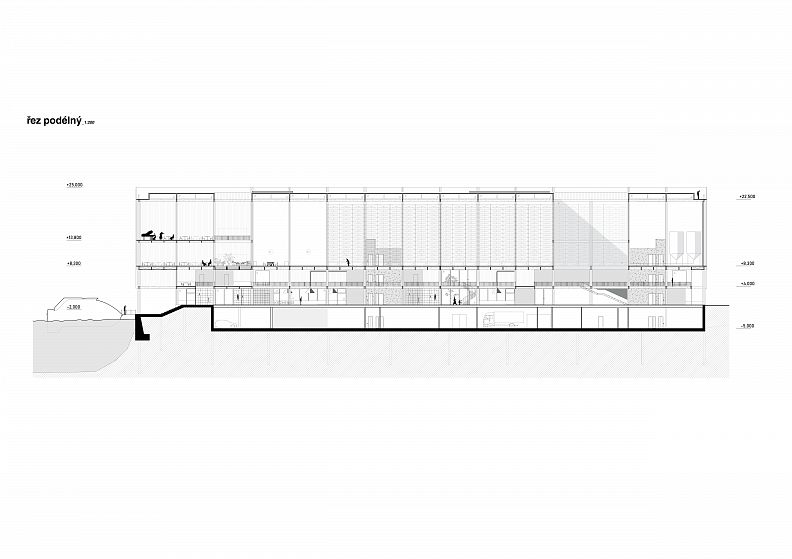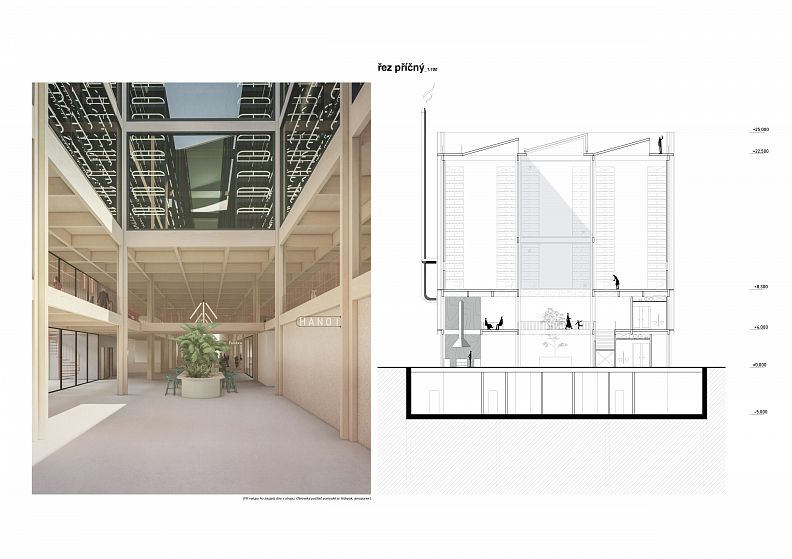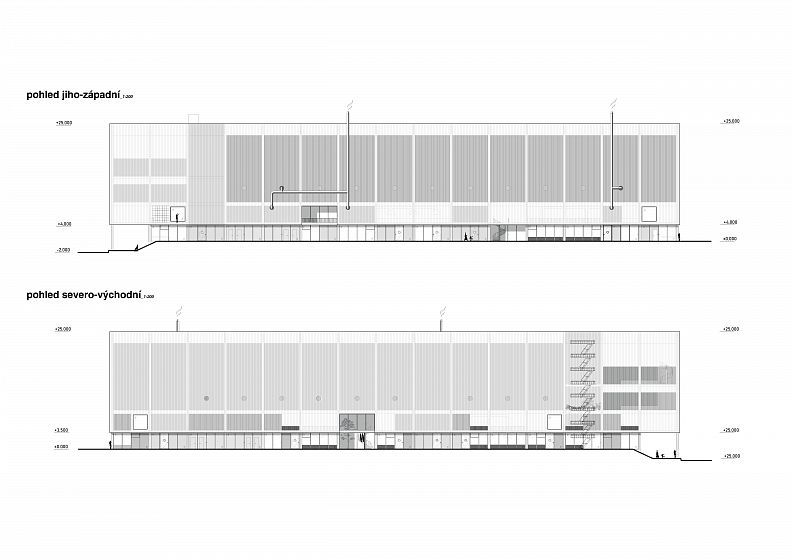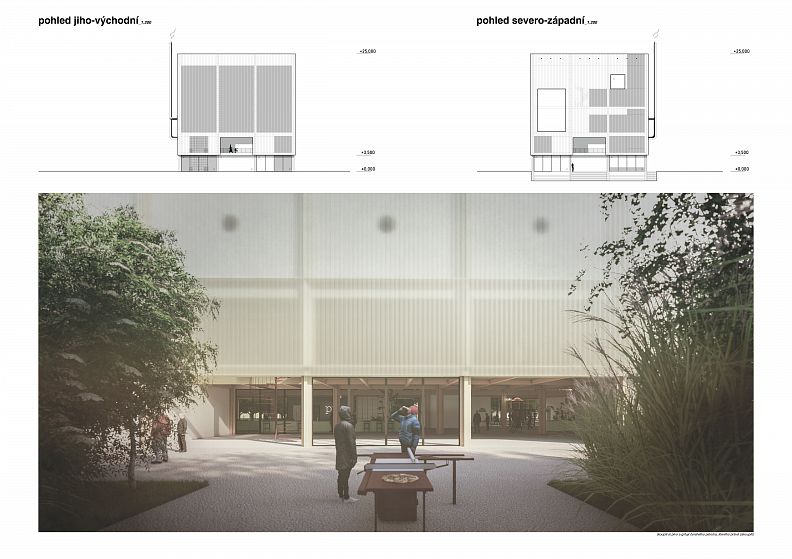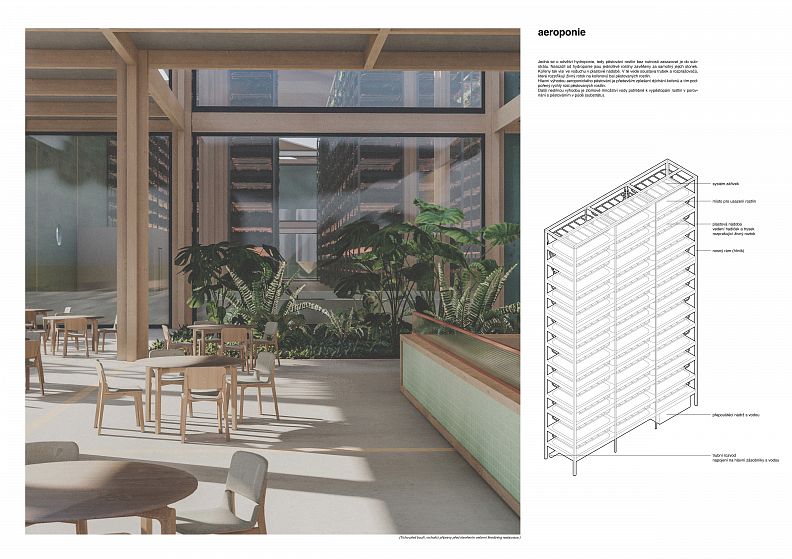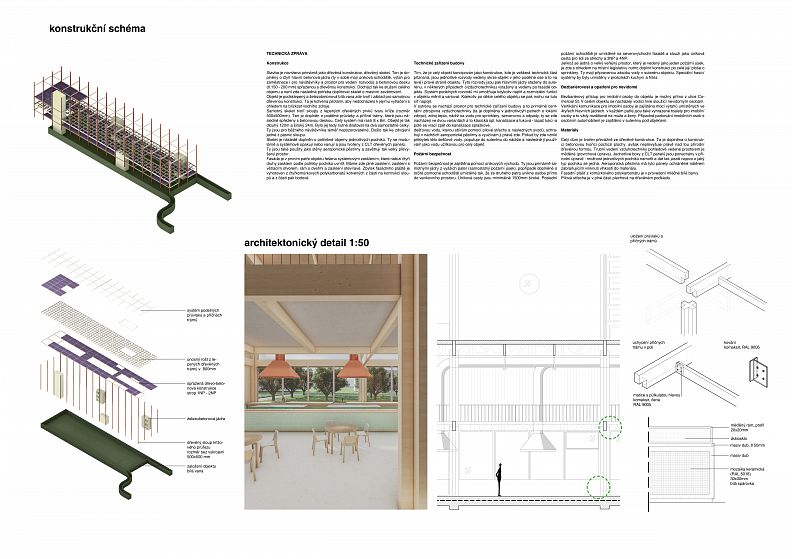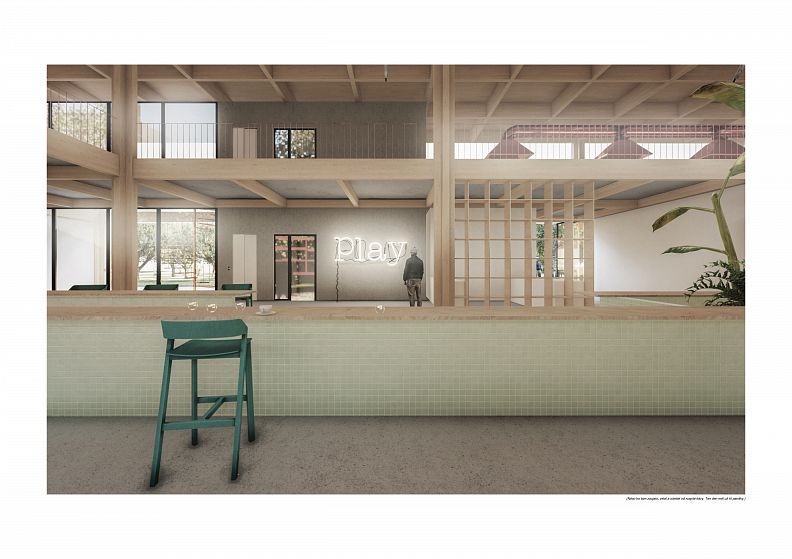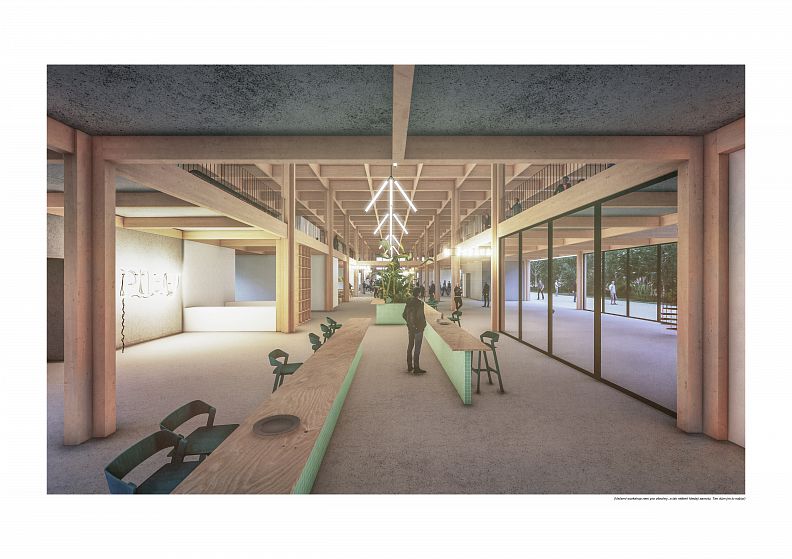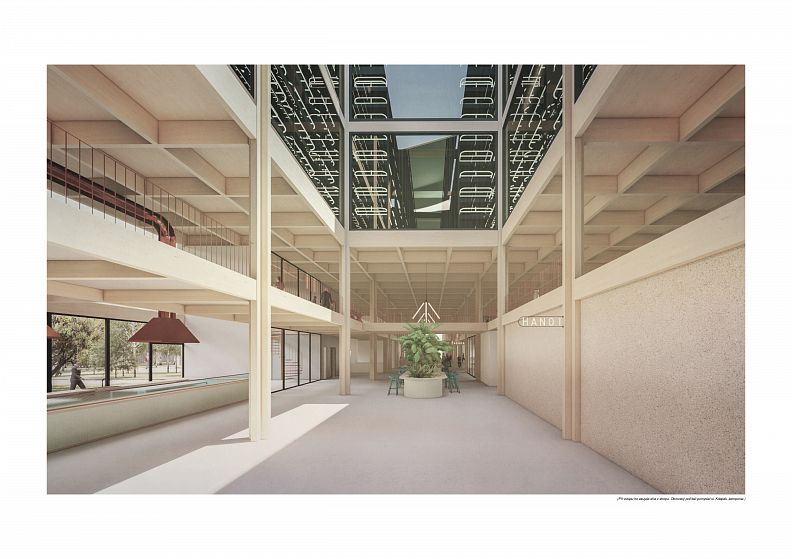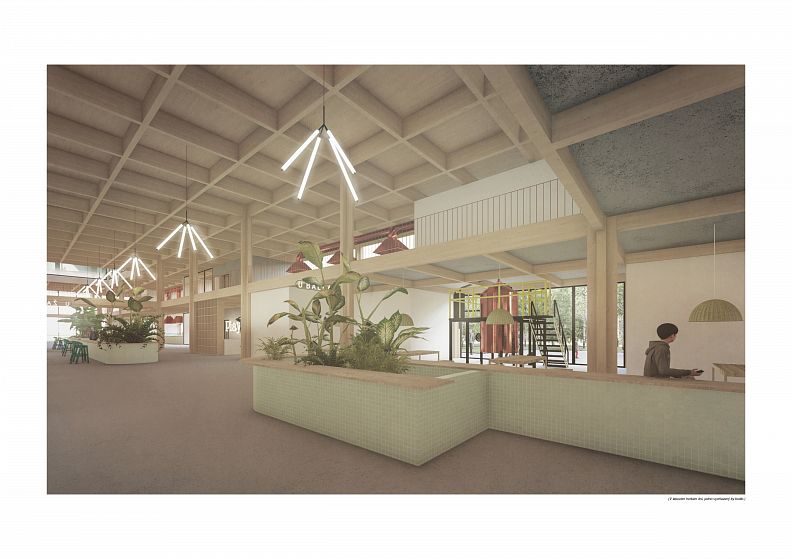Centrum drobné gastronomie v Brooklynu / Centre of small gastronomy in Brooklyn

Project idea
ZADÁNÍ
Zadáním pro mne bylo vytvoření nového centra drobné gastronomie. A to v New Yorku, Brooklynu ve čtvrti nesoucí název GREENPOINT. Parcelu o rozloze cca 10000 m2 jsem mohl zastavět pouze 30% plochy. Objekt měl mít do 50ti různých podniků, kde se bude jídlo připravovat podávat či pěstovat. Design měl být také efektivní, robustní a variabilní (flexibilní). Jako hlavní kritérium byl již v soutěži zmíněný požadavek food as experience, tedy mít zážitek a požitek ze stravování a ostatních činností v mnou navrhovaném objektu. Celý objekt měl být samozřejmě navržený tak, aby byl přizpůsoben místním podmínkám.
/
ASSIGNMENT
The task for me was to create a new center of small gastronomy. In New York, Brooklyn, in the GREENPOINT neighborhood. I could only build a 30% of the plot of land with an area of approximately 10,000 m2. The building was to have up to 50 different establishments where food will be prepared or served. The design should also be efficient, robust and variable. The main criterion already mentioned in the competition was the requirement of food as experience, ie to have the experience and enjoyment of eating and other activities in my proposed building. The whole building was, of course, to be designed to be adapted to local conditions.
Project description
MÍSTO
Návrh objektu na centrum drobné gastronomie se nachází v severní části Brooklynu zvané taky jako Greenpoint. Tato oblast je známá svou historií v oblasti průmyslu a to především v průmyslu lodním. Tato městská část je zároveň osídlená velkým množstvím Evropanů, převážně poláků, kteří zde uplatňovali svou pracovitost.
Samotná parcela o výměře něco málo přes 10000m2 sousedí přímo s
řekou East River a na straně pevniny je uzavřena ulicí Comercial St. Na
severo_výchdní části sdílí parcela hranu pozemku s historickým průmyslovým objektem, který dnes slouží pro více firem jako zázemí. Najdeme zde například výrobnu zmrzliny, kovárnu a výrobnu nožů a nebo studio, které vyrábí plastiky a struktury pro architekty a designéry. Na straně druhé, tedy jihozápadní sousedí s pozemkem, na kterém se nachází malá roztroušená zástavba sloužící nejspíše jako skladovací prostor a objemné parkoviště na zbytku parcely.
Parcela se nachází v meandru řeky East River a svým výhledem směřuje na Manhattan.
DŮM
Samotný objekt se na první zdání jeví jako jednoduchá hmota. Ta však
využívá zásadní spojnici, podélnou osu, mezi Commercial St a East River. Na pozemku je umístěna blíže k současnému objektu na severovýchodní straně, která slouží převážně k rannímu zásobování. Na straně jihozápadní se nám tak více otevírá a vytváří prostornou zahradu, která nabízí možnosti pro další případný vývoj území.
Celkově se hmota objektu, jak půdorysně, tak výškově chová ohleduplně k okolní zástavbě. Pří příchodu k hlavnímu vchodu do objektu, tedy z Commercial St. vnímá návštěvník právě převládající podélnou linii budovy. tak je umocněna při samotném vstupu do ní. Celý objekt je řešen jako masivní dřevostavba umocňující požitek z jídla a vytváří tak daleko příjemnější a teplé prostředí. První dvě patra jsou vyhrazena především pro prostory restaurací, bufetů, kaváren, pivnic, vináren, pivovaru a mnoho dalších. Jedná se o jednoduchý traktový systém, ve kterém je prostřední pruh zcela volný a nebrání zde (až na barové posezení) nic v průchodu a pohybu lidí od ulice k vodě a tedy nové stanici water-taxi, kterou zde umisťuji.
Po levé a pravé straně parteru si tedy všímáme různorodosti jednotlivých prostorů, které jsou někde převýšené přes obě patra a jinde naopak vytvářejí příjemné zákoutí, kde se návštěvník může „zašít“. Vystoupáme-li na druhé patro nacházíme se na jakési galerii usměrňující zrak do prostoru. Z levé a pravé galerie můžeme přecházet pomocí můstků, popřípadě použít schodiště zasazené v prostoru, popř výtah.
Tyto dvě patra gatro. podniků jsou následně ve skoro celé délce objemu zaklopeny hmotou, která nám tvoří prostor pro vytvoření aeroponické pěstírny. Ta reaguje na současnou situaci s nedostatkem vody a zároveň na někdy až příliš nesmyslný vývoz a dovoz potravin (surovin). Tato pěstírna návštěvníkům umožňuje do svých útrob nahlédnout několika místy a poukázat tak na již zmíněné problémy a nastínit možné řešení. Jedním z hlavních náhledů do této pěstírny se návštěvníkovi naskytne ihned po vstupu do objektu, de je skrze celý objem budovy vedena díra až na střechu objektu. Druhá možnost nahlédnutí do prostor aeroponické pěstírny se nachází v prostorách finedining restaurací sídlících v samotném čele objektu. V této části se tedy již pěstírna samotná nachází. V neposlední řadě lze do pěstírny nahlédnou shora ze střechy skrze pilové světlíky.
V neposlední řadě se v části objektu, která dojíždí až k hraně pozemku a k řece East River, nachází sestup k vodě a vytvoření tak příjemného krytého posezení při čekání na water-taxi. To vše s výhledem na Manhattan.
ZAHRADA
Nemalou součástí samotného návrhu byl zbytek parcely. Ten jsem se
snažil co nejvíce zatravnit a zalesnit a vytvořit tak další příjemné „zelené“ místo v Greenpointu, kterých se tu nachází opravdu po málu. Největší zpevněná plocha je vytvořena před hlavním vstupem do objektu. Ta je vydlážděna a slouží jako místo, kam může zajet několik foodtrucků s občerstvením, popřípadě zde může v teplých dnech vzniknout venkovní tržiště. Zbytek zahrady má Několik částí. Těmi jsou ostrůvky s jablečnými sady, dále také ostrůvek s různorodou zelení, ve kterém se nacházejí místa s venkovními veřejnými grily a posezením a pěšiny prostupující tímto územím, kterými se návštěvník může dostat k zastávce water-taxi bez nutnosti vcházet do objektu.
/
LOCATION
The design of the building for the center of small gastronomy is located in the northern part of Brooklyn, also known as Greenpoint. This area is known for its history in the field of industry, especially in the shipping industry. This part of the city is also inhabited by a large number of Europeans, mostly Poles, who used their hard work here.
The plot itself with an area of just over 10,000 square meters is directly adjacent to East River and on the mainland side it is closed by Comercial St. On in the north-eastern part, the plot shares the edge of the plot with a historic industrial building, which today serves as a background for several companies. Here you will find, for example, an ice cream factory, a smithy and a knife factory, or a studio that produces sculptures and structures for architects and designers. On the other hand, the southwest is adjacent to the land, on which there is a small scattered development, which probably serves as storage space and a large parking lot on the rest of the plot.
The plot is located in the meander of the East River and overlooks Manhattan.
HOUSE
At first glance, the object itself appears as a simple substance. That one, however
uses a major link, the longitudinal axis, between Commercial St and the East River. The plot is located closer to the current building on the northeast side, which is used mainly for morning supplies. On the southwest side, it opens up more to us and creates a spacious garden, which offers opportunities for further possible development of the area.
Overall, the mass of the building, both in plan and in height, behaves respectfully to the surrounding buildings. On arrival at the main entrance to the building, ie from Commercial St. the visitor perceives the prevailing longitudinal line of the building. so it is amplified at the very entrance to it. The whole building is designed as a massive wooden structure that enhances the enjoyment of food and creates a much more pleasant and warm environment. The first two floors are reserved mainly for restaurants, cafeterias, cafes, pubs, wine bars, a brewery and many others. It is a simple tract system in which the middle lane is completely free and there is nothing (except for the bar seating) preventing anything in the passage and movement of people from the street to the water and thus the new watertaxi station, which I place here.
On the left and right side of the ground floor, we notice the diversity of individual spaces, which are somewhere elevated over both floors and elsewhere create a pleasant corner, where the visitor can "sew". When we ascend to the second floor, we are in a kind of gallery directing our eyes into space. From the left and right galleries we can cross using bridges, or use a staircase set in space, or an elevator.
These two floors are gatro. companies are then covered in almost the entire length of the mass, which creates space for us to create an aeroponic growing room. It responds to the current situation of water shortages and at the same time to the sometimes too meaningless export and import of food (raw materials). This growing room allows visitors to look into its bowels in several places and thus point out the already mentioned problems and outline possible solutions. One of the main views of this growing room is to show the visitor immediately after entering the building, through which a hole is led through the entire volume of the building to the roof of the building. The second possibility of insight into the premises of the aeroponic growing room is located in the premises of the finedining restaurants located at the very head of the building. In this part, the growing room itself is no longer available. Last but not least, the growing room can be seen from above from the roof through saw skylights.
Last but not least, in the part of the building that travels to the edge of the plot and to the East River, there is a descent to the water and creating a pleasant covered seating area while waiting for a water taxi. All with a view of Manhattan.
GARDENS
An important part of the design itself was the rest of the plot. That's me
he tried to grass and afforest as much as possible and thus create another pleasant "green" place in Greenpoint, of which there are really few. The largest paved area is created in front of the main entrance to the building. It is paved and serves as a place where several food trucks with refreshments can go, or there can be an outdoor market on warm days. The rest of the garden has several parts. These are islands with apple orchards, as well as an island with diverse greenery, in which there are places with outdoor public grills and seating and footpaths through this area, through which the visitor can get to the watertaxi stop without having to enter the building.
Technical information
Konstrukce
Stavba je navržena primárně jako dřevěná konstrukce, dřevěný skelet. Ten je doplněný o čtyři hlavní betonová jádra (ty v sobě mají úniková schodiště, výtah pro zaměstnance i pro návštěvníky a prostor pro vedení rozvodů) a betonovou desku (tl.150 - 200 mm) spřaženou s dřevěnou konstrukcí. Dochází tak ke ztužení celého objemu a není zde následná potřeba doplňovat skelet o masivní zavětrování. Objekt je podsklepený a železobetonová bílá vana zde tvoří i základ pro samotnou dřevěnou konstrukci. Ta je kotvena pilotami, aby nedocházelo k jejímu vytlačení s ohledem na blízkost vodního zdroje.
Samotný skelet tvoří sloupy z lepených dřevěných prvků tvaru kříže (rozměr 500x500mm). Ten je doplněn o podélné průvlaky a příčné trámy, které jsou následně spřaženy s betonovou deskou. Celý systém má rastr 8 x 8m. Objekt je tak dlouhý 120m a široký 24m. Bylo jej tedy nutné dilatovat na dva samostatné celky. Ty jsou pro běžného návštěvníka téměř nepozorovatelné. Došlo tak ke zdvojení jedné z pásnic sloupu. Skelet je následně doplněn o potřebné objemy jednotlivých podniků. Ty se modulárně a systémově opakují nebo variují a jsou tvořeny z CLT dřevěných panelů. Ty jsou také použity jako stěny aeroponické pěstírny a zavětrují tak velký převýšený
prostor. Fasáda je v prvním patře objektu řešena systémovým zasklením, které nabízí čtyři druhy zasklení podle potřeby podniků uvnitř. Máme zde plné zasklení, zasklení s větracím otvorem, rám s dveřmi a zasklení otevíravé. Zbytek fasádního pláště je vyhotoven z čtyřkomůrkových polykarbonátů kotvených z části na konstrukci sloupů a z části pak bodově.
Technické zařízení budovy
Tím, že je celý objekt koncipován jako konstrukce, kde je veškerá technická část přiznaná, jsou jednotlivé rozvody vedeny skrze objekt v jeho podélné ose a to na levé i pravé straně objektu. Tyto rozvody jsou pak hlavními jádry staženy do suterénu, v některých případech (vzduchotechnika) vytaženy a vedeny po fasádě objektu. Systém podélných rozvodů mi umožňuje kdykoliv náplň a rozmístění funkcí v objektu měnit a variovat. Kdekoliv po délce celého objektu se pak mohu na tuto
síť napojit. V suterénu se nachází prostor pro technické zařízení budovy a to primárně centrální sdrojovna vzduchotechniky (ta je doplněna v jednotlivých patrech o lokální zdroje), zdroj tepla, nádrž na vodu pro sprinklery, serverovnu a odpady, ty se zde nacházejí ve dvou variantách a to klasická spl. kanalizace a tuková - lapač tuků -a
poté se vrací zpět do kanalizace splaškové. dešťovou vodu, kterou sbírám pomocí pilové střechy a následných svodů, schraňuji
v nádržích aeroponické pěstírny a využívám ji právě zde. Pokud by zde vznikl přebytek této dešťové vody, poputuje do suterénu do nádrže a následně ji používám jako vodu užitkovou pro celý objekt.
Požární bezpečnost
Požární bezpečnost je zajištěna pomocí únikových východů. Ty jsou primárně samotnými jádry z vyšších pater (samostatný požární úsek), popřípadě doplněné o točité pomocné schodiště umístěné tak, že ze druhého patra unikne osoba přímo do venkovního prostoru. Únikové cesty jsou minimálně 1500mm široké. Poslední požární schodiště je umístěné na severovýchodní fasádě a slouží jako úniková cesta pro lidi ze střechy a 3NP a 4NP. Jelikož se jedná o velký veřejný prostor, který je vedený jako jeden požární úsek, je zde s ohledem na místní legislativu nutno doplnit konstrukci po celé její ploše o sprinklery. Ty mají připravenou zásobu vody v suterénu objektu. Speciální hasící systémy by byly umístěny v prostorách kuchyní a fritéz.
Bezbariérovost a opatření pro nevidomé
Bezbariérový přístup pro imobilní osoby do objektu je možný přímo z ulice Comercial St. V celém objektu se nacházejí vodící linie sloužící nevidomým osobám. Vertikální komunikace pro imobilní osoby je zajištěna mocí výtahů umístěných ve čtyřech hlavních jádrech. v každém patře jsou také vyhrazené toalety pro imobilní osoby a to vždy rozdělené na muže a ženy. Případné parkování imobilních osob s osobním automobilem je zajištěno v suterénu pod objektem.
Materiály
Celý dům je tvořen převážně ze dřevěné konstrukce. Ta je doplněna o konstrukci betonovou tvořící pochozí plochy, avšak nepřevyšuje právě nad tou přírodní dřevěnou formou. Trubní vedení vzduchotechniky pohledově vedené prostorem je měděné (povrchová úprava). Jednotlivé boxy z CLT panelů jsou ponechány v přírodní úpravě - možnost jednotlivých podniků namořit a dát tak jasně najevo o jaký
typ podniku se jedná. Aeroponická pěstírna má tyto panely ochráněné nátěrem zabraňujícím vniknutí vlhkosti do materiálu. Fasádní plášť z komůrkového polykarbonátu je v provedení mléčné bílé barvy.
Pilová střecha je v plné části plechová na dřevěném podkladu.
/
Construction
The building is designed primarily as a wooden structure, a wooden skeleton. It is complemented by four main concrete cores (these have escape stairs, an elevator for employees and visitors and space for wiring) and a concrete slab (thickness 150 - 200 mm) coupled with a wooden structure. This tightens the entire volume and there is no subsequent need to supplement the skeleton with a massive wind. The building has a basement and a reinforced concrete white tub forms the basis for the wooden structure itself. It is anchored by the piles so that it is not pushed out with regard to the proximity of the water source.
The skeleton itself consists of columns made of glued wooden elements in the shape of a cross (size 500x500mm). It is supplemented by longitudinal beams and transverse beams, which are then coupled with a concrete slab. The whole system has a grid of 8 x 8m. The building is 120m long and 24m wide. It was therefore necessary to dilate it into two separate units. These are almost unobservable for the average visitor. One of the flanges of the column was doubled. The skeleton is then supplemented with the necessary volumes of individual companies. These are modularly and systemically repeated or varied and are made of CLT wooden panels. These are also used as walls of an aeroponic grow room and wind up a large cantilever
space. The facade is solved on the first floor of the building by system glazing, which offers four types of glazing according to the needs of the companies inside. We have full glazing, glazing with a ventilation hole, a frame with a door and opening glazing. The rest of the façade cladding is made of four-chamber polycarbonates anchored partly on the construction of the columns and partly in points.
Technical equipment of the building
Because the whole building is designed as a structure, where all the technical part is acknowledged, the individual distributions are routed through the building in its longitudinal axis on the left and right side of the building. These distributions are then pulled into the basement by the main cores, in some cases (air conditioning) pulled out and led along the facade of the building. The system of longitudinal distributions allows me to change and vary the content and distribution of functions in the building at any time. Anywhere along the length of the whole object I can then turn to this
connect the network. In the basement there is a space for technical equipment of the building, primarily a central air conditioning source (which is supplemented on each floor by local sources), heat source, water tank for sprinklers, server room and waste, these are located in two variants, namely the classic spl. sewer and grease - grease trap -a
then it returns to the sewer. I store rainwater, which I collect with the help of a saw roof and subsequent drains
in the tanks of an aeroponic grow room and I use it right here. If there is an excess of this rainwater, it will go to the basement in the tank and then I use it as utility water for the whole building.
Fire safety
Fire safety is ensured by means of escape exits. These are primarily the very cores from the upper floors (a separate fire section), or supplemented by a spiral auxiliary staircase located so that a person escapes directly from the second floor into the outdoor area. Escape routes are at least 1500 mm wide. The last fire escape is located on the northeast facade and serves as an escape route for people from the roof and the 3rd and 4th floors. As this is a large public space, which is managed as a single fire section, it is necessary with regard to local legislation to supplement the structure over its entire area with sprinklers. They have a ready supply of water in the basement of the building. Special fire extinguishing systems would be located in kitchen and fryer areas.
Accessibility and measures for the blind
Barrier-free access for immobile persons to the building is possible directly from Comercial St. There are guide lines in the whole building serving blind people. Vertical communication for immobile people is ensured by the power of elevators located in the four main cores. on each floor there are also dedicated toilets for the immobile, always divided into men and women. Eventual parking of immobile persons with a car is provided in the basement under the building.
Materials
The whole house consists mainly of wooden structures. It is complemented by a concrete structure forming walkable surfaces, but it does not exceed just that of the natural wooden form. The piping of the air technology visually guided by the space is made of copper (surface treatment). Individual boxes made of CLT panels are left in a natural finish - the possibility of individual companies to infest and thus make it clear what
the type of business in question. The aeroponic growing room has these panels protected by a coating that prevents moisture from entering the material. The facade cladding made of cellular polycarbonate is in a milky white color.
The saw roof is fully made of sheet metal on a wooden base.
